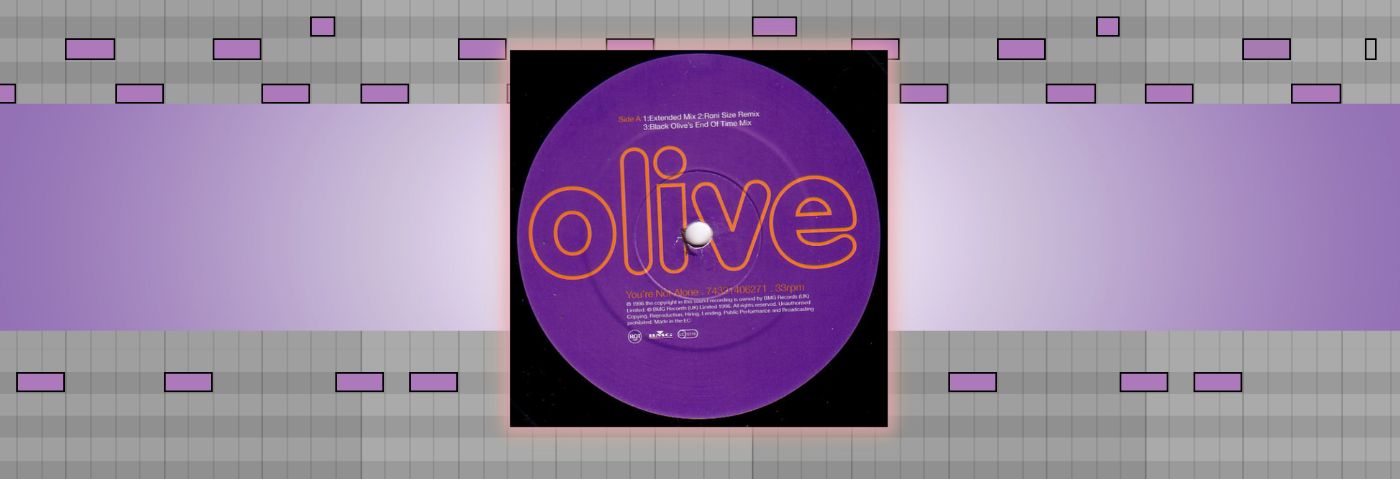In this Beat Dissected, we turn our attention to the break beat infused trip-hop of Olive’s You’re Not Alone.
London-based trip-hop trio Olive had a short-lived career. The band only released two albums 1997’s Extra Virgin and 2000’s Trickle, but in that time they managed to make a sizable impact on the UK music scene, not least thanks to their smash hit single ‘You’re Not Alone’.
You’re Not Alone was first released in 1996, but would go on to find great commercial success in 1997 when it would hit the top spot in the British charts and would win the Best Dance Music category at the Ivor Novello Awards.
25 years on and the track remains culturally significant. FKA Twigs recently borrowed the chorus for her Jorja Smith and Unknown T collaboration Darjeeling, illustrating the timelessness of the Ruth-Ann Boyle sung original.
In this Beat Dissected we will be recreating the beat in Ableton Live using trip hop staples the Roland 909 and a sliced-up breakbeat.
Spec
Tempo
134 BPMSwing
50%Sounds
AbletonHere’s what we’re making:
And here’s the beat with a bit of music for context:
Remember to click any image to enlarge!
Step 1: Kick
Most of our beat is going to be written using a sampled breakbeat.
Though most producers do steal breaks from classic records, we’re going to be using one of the many great royalty-free breakbeats available in Ableton Live’s various packs. ‘Break Games You Play 100bpm’ from the Core Library has the right tone for this Olive-inspired beat.
Right-click on the sample in the finder and select ‘Slice to New MIDI track’ from the right-click menu. In the dialogue box select create one slice per transient from the drop-down menu and use the built-in slicing preset.

This will automatically create a drum rack with a drum hit from the breakbeat on each pad.
Bring the Loop Length down to 0 using the drum rack’s automatically created macros.

Create a four-bar MIDI clip and program the below kick pattern.

Step 2: Snare
Time to add our snare. We’re recreating the pattern from the chorus of You’re Not Alone which includes a snare roll at the end of the four bar pattern.
Using a snare hit from a break beat drum rack program the below pattern. Notice how the velocity ramps during the snare roll.

Step 3: Breakbeat hi-hats
The beat if You’re Not Alone is quite a straight breakbeat reinterpretation AKA there’s no swing and hardly any ghost notes. Add closed hats in some of the spaces between the kick and snare hits in the below pattern.

Be sure to use more than one of the hi-hats from the sliced breakbeat for variation in texture.
Step 4: 909 hi-hats
Though the majority of this Olive inspired pattern has been written using a sampled breakbeat, we will get our hat sound from Ableton’s 909 core kit. Load it on an empty MIDI channel.
To get the kit sounding nice and analogue we’ll add some drive and compression. Using the macros in the 909 kit boost the Drive Amount, Drive Tone, Glue and High Gain dials.
Having applied gain make sure you balance the output by reducing the global Gain dial.

Program the below pattern using the closed hat, open hat, and crashes in the 909 rack. Note the changes in velocity for an extra touch of humanity.

Reverse the final snare hit in Drum Rack to provide a mini riser at the end of the pattern.

Step 5: Global processing
With our beat programmed it’s time to bring all of the elements together with some global processing.
Group the two drum tracks together. Load Reverb and Glue Compressor on the group in that order.
Dial in around 700ms of decay with the reverb unit and set the wet amount to around 10%. With Glue Compressor set the attack and decay to medium speed and the ratio to 4:1. We’re aiming for around 5dB of gain reduction so set the threshold accordingly.







